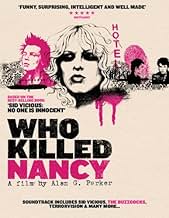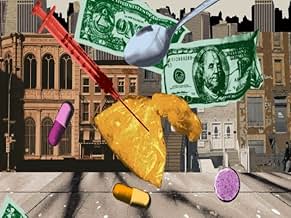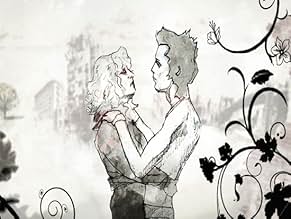Ajouter une intrigue dans votre langueOn October 12th 1978 New York Police discovered the lifeless body of a 20 year-old woman, slumped under the bathroom sink in a hotel room. She was dressed in her underwear and had bled to de... Tout lireOn October 12th 1978 New York Police discovered the lifeless body of a 20 year-old woman, slumped under the bathroom sink in a hotel room. She was dressed in her underwear and had bled to death from a stab wound. The woman was Nancy Spungen, an ex-prostitute, sometimes stripper, ... Tout lireOn October 12th 1978 New York Police discovered the lifeless body of a 20 year-old woman, slumped under the bathroom sink in a hotel room. She was dressed in her underwear and had bled to death from a stab wound. The woman was Nancy Spungen, an ex-prostitute, sometimes stripper, heroin addict, and girlfriend of Sex Pistols' bassist Sid Vicious. In a trial by tabloid n... Tout lire
- Self - Contributor
- (as George X)
- Self - Photographer
- (as Peter 'Kodick' Gravelle)
Avis à la une
The actual effect of this lack of strict focus, is paradoxically, a masterpiece in capturing the character and spirit of both the people involved, and of the music scene that they came from.
Punk was, and is, purposely confrontational, and many punk documentaries are effectively impaled on these clashes; stuck on the 'spikes' of punk, and never really capturing a complete image of either the people or the scene. In setting out to chronicle a death, this film has actually captured that life.
It would probably be foolish to imagine that any film can actually tell you all about punk; who has seen a documentary that actually even had all of the important bands in it? This film is not all of punk by any means, but it is one of the best documentaries to have come out of it, and that is what really matters.
If you are focused on the film from the perspective of the mystery however, this film is still a great success, at least if you would like to make up your own mind. Most films of this sort would have the filmmaker smacking away with remark after remark, all up and down the length of the film, like a cook tenderizing a piece of meat. In this case, it seems like such remarks had to be pasted onto the end of the film, but since both sides of the evidence are presented relatively naturally along the course of the film, the effect is to create overall, an unusually unbiased presentation. This documentary is rough around the edges, but it is great.
To the weird cast of interviewees who drive this sordid narrative, that is a vile slur on the sensitive and caring Sid of their increasingly dim and distorted memories. But if you die at 21, you soon morph into some kind of martyr-legend, so we are supposed to keep a straight face while the two of them are seriously compared to Romeo and Juliet. Near the beginning, a voice-over laments "Underneath that exterior, there was a really nice guy." Further in, we catch an example of this niceness, when he tortures and strangles a cat, which then has the impudence to release bodily fluids in its death-throes.
Sid's own death is given a lot too much prominence, considering that it is technically off-topic, having occurred a few months after Nancy's, and this is a sign of the shapeless direction of the film. It is mainly an impressionist picture of the Sid and Nancy story, showing that she was effectively murdered not by a person but by a particular culture, where the decencies are ridiculed, crime and debauchery glamorised, and all limits and restraints shoved aside. Significantly, the film is often padded-out with blurred images of slow-moving shadow-figures of uncertain gender, just drifting about in some limbo.
That is at least symbolic of the chaotic last months of their life together, holed-up in Manhattan's Chelsea Hotel, following the break-up of the Sex Pistols. The Chelsea, as presented, takes bohemianism to giddy heights - dealers everywhere, little groups meeting on the stairs, total strangers wandering in and out of rooms.
It may sound like a schoolboy's dream, this life of non-stop hedonism, but nobody could have called Sid and Nancy a happy couple. If the film reveals anything, it is just how well-earned was the label 'Nauseating Nancy'. Superficially, you could start to find her vaguely attractive in the pop-eyed Molly Parkin style, but a closer look reveals a terrifying madness. Women loathed her piercing voice, and just wanted to get away. And although she claimed she would make a good manager for Sid, that was not too likely, considering her habit of dropping banknotes all over the reception area without noticing. Indeed, some say it was a particular pile of banknotes, found missing from their room, that pointed to the killer, supposedly a mysterious gay dealer who thought he'd been swindled.
But any attempt to explain it in terms of likelihood or logic is doomed, against the general background of narcotic blundering about that clearly left Nancy bleeding to death, slumped awkwardly on that bathroom floor. 'Who Cares Who Killed Nancy?' might have been a better title. The cops knew what they were talking about when they said they had better things to do.
It's a fair representation of the underground pre-punk and punk scene in New York City by the people who lived through it, which is honestly probably the most compelling aspect of Who Killed Nancy? Rather than solving the mystery of the title person's 1978 murder. Let's face it - most of us bought into the story that an angry, mentally ill, and addicted Sid Vicious "accidentally" committed manslaughter in the middle of an argument accompanied by domestic violence.
But now I don't know, there are so many details that never came to light publicly until this documentary was made, apparently. It tracks because it was difficult to solve murders 40-50 years ago compared to today and no one really cared about a couple of "has been" junkies living in the latter days of the Chelsea Hotel.
Meilleurs choix
Détails
Box-office
- Budget
- 300 000 £GB (estimé)
- Montant brut mondial
- 2 294 $US
- Durée1 heure 40 minutes
- Couleur
Contribuer à cette page






























